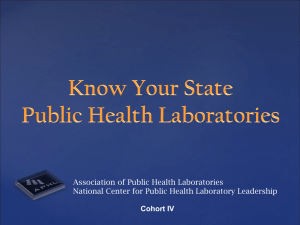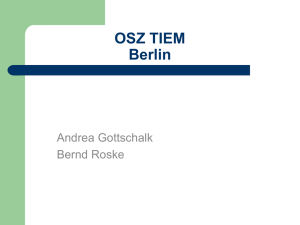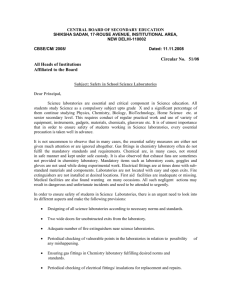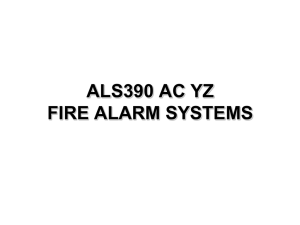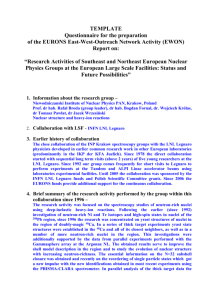SAF 001 - Health and Safety
advertisement
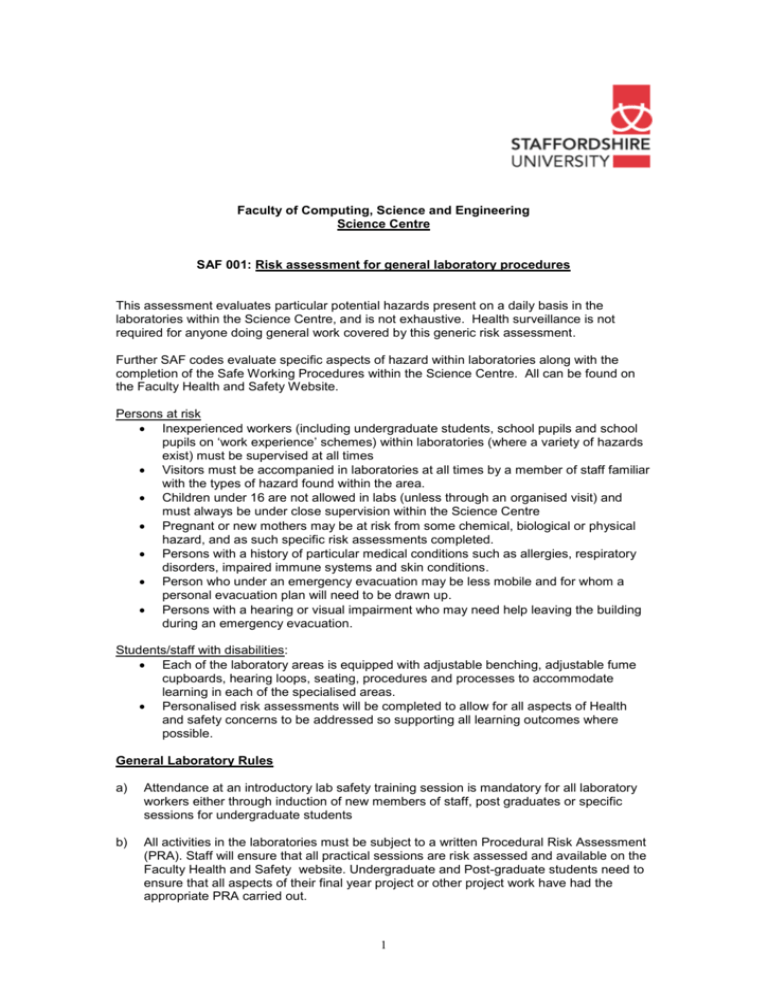
Faculty of Computing, Science and Engineering Science Centre SAF 001: Risk assessment for general laboratory procedures This assessment evaluates particular potential hazards present on a daily basis in the laboratories within the Science Centre, and is not exhaustive. Health surveillance is not required for anyone doing general work covered by this generic risk assessment. Further SAF codes evaluate specific aspects of hazard within laboratories along with the completion of the Safe Working Procedures within the Science Centre. All can be found on the Faculty Health and Safety Website. Persons at risk Inexperienced workers (including undergraduate students, school pupils and school pupils on ‘work experience’ schemes) within laboratories (where a variety of hazards exist) must be supervised at all times Visitors must be accompanied in laboratories at all times by a member of staff familiar with the types of hazard found within the area. Children under 16 are not allowed in labs (unless through an organised visit) and must always be under close supervision within the Science Centre Pregnant or new mothers may be at risk from some chemical, biological or physical hazard, and as such specific risk assessments completed. Persons with a history of particular medical conditions such as allergies, respiratory disorders, impaired immune systems and skin conditions. Person who under an emergency evacuation may be less mobile and for whom a personal evacuation plan will need to be drawn up. Persons with a hearing or visual impairment who may need help leaving the building during an emergency evacuation. Students/staff with disabilities: Each of the laboratory areas is equipped with adjustable benching, adjustable fume cupboards, hearing loops, seating, procedures and processes to accommodate learning in each of the specialised areas. Personalised risk assessments will be completed to allow for all aspects of Health and safety concerns to be addressed so supporting all learning outcomes where possible. General Laboratory Rules a) Attendance at an introductory lab safety training session is mandatory for all laboratory workers either through induction of new members of staff, post graduates or specific sessions for undergraduate students b) All activities in the laboratories must be subject to a written Procedural Risk Assessment (PRA). Staff will ensure that all practical sessions are risk assessed and available on the Faculty Health and Safety website. Undergraduate and Post-graduate students need to ensure that all aspects of their final year project or other project work have had the appropriate PRA carried out. 1 c) The PRA must be available for inspection while working in the Laboratories. d) Do not enter a laboratory unless a member of staff is present e) PPE will be worn as required. All personal possessions other than those required only for laboratory work will be stored within the digital lockers provided outside each laboratory area. Students must comply with any safety instructions given by academic or technical staff. f) PPE must be removed upon leaving the laboratory. g) Keep the gangways and benches in the laboratories as clear as possible. h) Do not sit on benches. i) Lay out apparatus in an orderly fashion, to avoid reaching or leaning across hazards. Tidy work is more efficient and carries less risk of mistakes. j) Eating, drinking and smoking in the laboratories is forbidden. k) Mouth pipetting is prohibited l) POWDERED LATEX GLOVES are prohibited within the laboratories. Low protein, non-powdered latex gloves can be used under specific circumstance, but the norm is for nitrile disposable gloves (to EN374-2 and EN 375-3 standard) m) To avoid contaminating door handles and light switches gloves must not be worn outside the laboratory n) Lab coats are NOT to be worn outside the laboratory area o) The use of personal communication and entertainment devices in laboratories is restricted, and to be used only for educational purposes. Please refer to SAF code 13 p) Do not keep snacks or drinks containers in the pockets of your laboratory coat. q) Anyone who is, in the opinion of the laboratory supervisor, under the influence of either alcohol or drugs or behaves in a manner that will injure fellow students or staff will be excluded from the laboratory session and will be subject to further disciplinary action. r) Students are strongly advised to wear safety glasses if you have contact lenses in the laboratory. This is because of the following hazards: 1. Organic solvent splash which dissolves the contact lens onto the eye. 2. Corrosive vapours may migrate behind the lens and dissolve in the tears. This could cause permanent damage to the eye. Any student continuing to wear contact lenses without protection does so at their Own risk. s) Always tie back long hair. t) Wear sensible foot wear (not sandals, high heels etc). u) All chemicals should be handled with great care, according to the PRA and COSHH assessment. 2 v) Spillages must be cleaned up immediately and neutralised where appropriate. All spillages must be reported to the Supervising Staff. w) Flammable liquids should be used in a fume cupboard or a well ventilated area away from possible sources of ignition. x) Mercury vapour is toxic. All spillages of mercury must be reported to a member of the technical staff immediately for clean up. y) Do not interfere with equipment that has not been allocated to you. z) Good standards of personal hygiene must be maintained at all times. Hand-to-face operations must be avoided. Hands must be washed when leaving a ‘wet’ laboratory. Most importantly if you have any doubts concerning safety, consult a member of staff. In addition all defects in equipment and systems of work should be reported immediately to a member of Academic or Technical staff. Service shut-downs in emergencies: Each ‘wet’ laboratory with a natural gas supply has an emergency gas shut-off panel (gasguard) just inside the door. An alarm will sound if any gas supply is left on without ignition and the supply will shut down, similarly this will happen under actual fire activation. Specific ‘wet’ laboratories with specialised gases similarly have gas detectors which will alarm and shut down in the event of gaseous release or actual fire activation. All labs are fitted with RCD’s (residual current device) to prevent electrocution and all fume cupboards are fitted with emergency cut out switches for each fume cupboard. Fume cupboards will not function when the fire alarms are activated (except when alarms are being tested) Hazard Risk factors for consideration Risk control measures Release of hazardous gases, aerosols, volatile liquids or dusty solids Ensure hazard data is known through risk assessment and COSHH data Working in poorly ventilated areas Ensure appropriate storage, use, disposal and emergency procedures are in place before commencing work Chemicals Depending on the specific compound, chemicals have the potential to be poisonous (toxic, including carcinogens, teratogens and mutagens), burn (corrosive), irritate, produce allergenic reactions, explode, ignite or asphyxiate. Using incorrect PPE Incorrect disposal of chemicals Work involving airborne release must be done within a fume containment facility Wear correct PPE Some specified chemicals cannot be used without following Home Office procedures Chemical disposal must be adhered to via your PRA 3 Biological agents May have the potential to cause disease by inhalation, ingestion or contact with wounds and mucous membranes, physical damage (animal bites and scratches) and allergies (by physical contact and inhaling allergenic dusts) Major potential route is by inhalation Refer to SAF 002 Precautions for Microbiological work and SAF 003 Disposal of microbiological waste Any work with GM (genetically modified) organisms to follow GM protocol and SAF 004 local rules for activities involving genetically modified organisms Categorise infection hazard (for this Faculty category 1 or 2) Refer to SAF 005 for use of Insectary Minimise the production of aerosols and contain any that are produced within Biological safety cabinets Working areas to be swabbed with decontaminate solution (2% virkon) Environmental projects assessed through fieldwork risk assessment when working with animals and through SAF 012 risks associated with contact with animals and animal byproducts Sharps Such as blades (scalpel and microtome), also shards of broken glass can cause physical injury Improper disposal of needles, blades and glass Removing caps from glass containers Promptly dispose of needles, blades and broken glass in the appropriate designated containers (glass bins, sharps containers and clinical sharps containers) Use of glass pipettes Take care with microtome and removing caps from glass containers’ Do not use damaged glassware Take care with the use of glass pipettes and rubber 4 teats Fires and burns Caused by ignition of flammable reagents and other materials by faulty electrical equipment. Carries the risk of death, personal injury and severe property damage. Work involving: Flammable organic solvents Ensure familiarity with fire emergency procedures Naked flames Remove waste promptly Cryogenic materials Store flammable organic solvents in fire-retardant cabinets and segregate from naked flames and electrical equipment Microwave ovens Burns can be received from Bunsen flames, handling hot objects (from autoclaves), and scalds from steam and superheated liquids (agar in a microwave oven, waterbaths) Ultra cold materials (liquid Nitrogen) Waterbaths Autoclaves Use of Winchester carriers for carrying bottles Hot water from some taps Using unsafe portable electrical equipment Use of apparatus involving high voltages (HV) or currents (e.g. electrophoresis equipment) Ensure PAT testing for all equipment Check re-test dates on portable electrical equipment and do not use if date has expired. (Contact Estates for re-test) Keep water away from mains electrical sockets Follow procedures for equipment use Only competent engineers to attempt repairs to electrical equipment Use heat resistant gloves for handling hot or cold items Use of liquid nitrogen refer to risk assessment Non-ionising radiation sources Such as Ultraviolet lamps, and microwave ovens, have the potential to damage tissues (particularly the eyes with UV) if exposed. Use of UV lamps for visualising bands on electrophoresis gels Lasers can permanently damage the eyes Use of microwave ovens for heating aqueous liquids and melting small volumes of solidified agar Ultrasound can damage hearing Using ultrasonic disintegrators Ensure UV shield is in place e.g. visualising equipment Wear polycarbonate safety spectacles or face shields when unshielded short-wave UV has to be used Regularly test microwave oven door seals for leakage of radiation Wearing hearing protection when using ultrasonics. 5 Gases Asphyxiant gases can deplete the oxygen in the air we breathe. Liquid nitrogen can produce large volumes of odourless gas which can accumulate, particularly in confined spaces (such as lifts) Storing or transporting liquid nitrogen in a confined space Release of large volumes of any asphyxiant gas from a compressed gas cylinder The storage and use of liquid nitrogen refer to risk assessment Ensure liquid nitrogen is stored and transported only in a cry-contained (dewar) and only used in well ventilated areas Specific laboratories or confined spaces to have appropriate signage and subject to a specific assessment Familiarity with the oxygen depletion alarms and systems for specific laboratories Familiarity with the gas detection alarms and systems for specific laboratories High pressure systems Specifically in gaseous and liquid systems, also vacuums Can cause problems when components fail. The resultant release of energy can project solids or liquids at high velocity Use of gases from compressed gas cylinders Specific equipment e.g. HPLC Familiarisation with the use of specific detection systems within laboratories and storage areas Use of PPE Autoclaves Specialised equipment use Noise Excessively loud noise can lead to hearing loss and tinnitus Ultrasonic disintegrators (sonicators) can affect others in the vicinity within the laboratory Reduce noise where possible Ear defenders must be worn Signage on doors when using a sonicator Trips, slips, falls and manual handling Can lead to severe injury in work areas where there maybe inappropriate storage of materials, wet floors, trailing cables and build up of waste material cold room floor within the Environmental lab liquid spillages on floors Follow recommendation on manual handling policy (Faculty health and safety Sciences website) Handling materials on shelves above head height Manual handling training specifically for those at risk Lifting or moving heavy containers Use appropriate safety ladders (that have been registered and checked), ‘Kiksteps etc. 6 Remove waste material promptly Repetitive movements Poor posture can lead to upper limb disorders in particular DSE assessment of any laboratory IT equipment where prolonged use is required Repetitive manual pipetting Assess equipment computer workstations If required use of powered pipettors if available First Aid For chemical or biological spillages on body surfaces (skin and eyes) remove contaminating material as soon as possible. This can be achieved by flushing the affected area with cold tap water for up to 15 minutes. Each ‘wet’ laboratory has a hand wash basin and hand-held wash shower. Emergency full showers are located on the 3rd floor lab R324 and ground floor lab 2 R019. For heat or cold burns the same remedy applies. Cold water effectively removes heat from a heat burn or increases the temperature of a cold-burn affected area. Flood the affected area for 15 minutes Minor cuts can be treated locally, First aid boxes can be found within each laboratory area. For emergency help contact ext 4444 and a list of Faculty first aiders is displayed on the Health and Safety notice boards within each lab For any injury if irritation persists then seek medical attention via the student health centre on 0300 1231765 or the University Hospital North Staffordshire Emergency care centre 01782 674455 Accident Reports Accident and incident (near miss) forms are available on the Faculty Health and Safety website. Accident reports must be completed soon as possible after the incident. All accidents, including near misses (incidents), must be reported. Fire Alarms Weekly fire alarm testing within the Science centre will occur at 10.30 am every Tuesday. In the event of actual fire activation follow the instruction to leave the building by fire marshals and congregate on the Trent car park until instructed to be allowed back into the building. Reviewed: July 2013 (Audra Jones) 7


